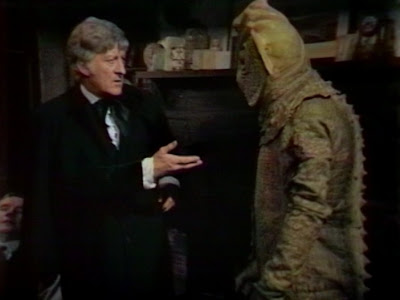 |
Episode Two, 17 April 1971
Episode Three, 24 April 1971
Episode Four, 1 May 1971
Episode Five, 8 May 1971
Episode Six, 15 May 1971
Written by Malcolm Hulke
Directed by Michael Briant
Script editor: Terrance Dicks
Produced by Barry Letts
Jon Pertwee as the Doctor
Roger Delgado as the Master
Nicholas Courtney as Brigadier Lethbridge-Stewart
Katy Manning as Jo Grant
And at last, two years after the Doctor last travelled in time and space, he's doing so again--though it's somewhat against his will. The Time Lords send him and Jo to the desert planet Uxarieus in the twenty-fifth century, where a small group of hardy human colonists are attempting to build a new life in the arid soil.
But all is not well in the colony. Some colonists see giant, dinosaur-like monsters roaming the plains at night, and a pair of homesteaders are killed, their bodies scarred with giant claw marks on their body. And a bedraggled hermit shows up (played by Roy Skelton, the voice of the Daleks), claiming to be the sole survivor of a former colony that was first attacked by these monsters, then destroyed by the planet's primitive humanoid inhabitants, who live in the ruins of a stone city some way to the south.
And then to top everything else off, a heavily-armed ship arrives from the Interstellar Mining Corporation, looking to exploit the planet's vast duralinium deposits for the voracious market on Earth. But to do so would destroy the planet as a livable habitat. The colonists claim that the miners are trespassing, and that the Earth government has allocated the planet for colonisation. But the miners' story is that a faulty computer on Earth must have allocated the planet both for colonisation and for exploitation; the only solution is to call in a legal official called an Adjudicator to settle the dispute.
What's really going on is that the mining ship know full well that it's the colonists who have rights to the planet, but they're trying to scare them away so that they can exploit its resources. They're manufacturing the monster sightings (there are no such monsters); they're killing the colonists and making it look like monster attacks; and the "survivor from a previous colony" is actually a spy from the mining ship's crew.
But things get more complicated when the Adjudicator arrives--because he turns out to be the Master, in disguise. The Master's interest is in the ruined city where the native primitives live. He has learnt that the extinct advanced civilisation from which the primitives descend created a doomsday weapon but never used it--a weapon that can turn any star nova in the blink of an eye, destroying any worlds that orbit it. The weapon still exists, somewhere beneath the city, and the Master wants to find it so he can hold the universe to ransom and make himself ruler of the cosmos. (That's, ruler of the cosmos, as in ruler of the universe, not ruler of the Cosmos, as in ruler of the New York team in the 60s/70s-era North American Soccer League.)
Open violence has now broken out between the miners and the colonists, with the miners eventually defeating and capturing the colonists. The captain of the mining ship convenes a kangaroo court and convicts the colony leader of treason, but he agrees to commute the death sentence on condition that the colonists depart the planet immediately. The colonists object--their ship was never intended to be flown again, and its engines are in such poor repair that they could well break up in flight. But the mining captain has no pity for them, and they have no choice. They depart, and their spaceship does indeed blow up moments after liftoff.
But it turns out there was only one person aboard--the colony leader, who sacrificed himself so that his colonists could live. The colonists themselves were in hiding, and once the miners think they've all died, they sneak back, mount an ambush and defeat the miners.
Meanwhile, the Doctor and the Master have headed to the primitives' city to find the doomsday weapon. But the ruler of the primitives turns out to be a tiny little being whose brain has expanded so much that he has developed powers of telepathy and telekinesis. He sees the evil in the Master and instructs the Doctor that, for the good of the galaxy, he must operate the self-destruct mechanism on the doomsday weapon. This also has the effect of destroying the ruined city, and the primitives themselves die when they refuse to leave their doomed home.
But the Doctor and the Master, of course, get out alive, and the Master escapes in his TARDIS. Their errand complete, the Doctor and Jo are returned to UNIT HQ by the Time Lords.
What Lisa thought
I think this is a pretty good story, and one whose main theme--the common man being screwed over by a powerful corporation surreptitiously aided by a government in thrall to the elite--resonates just as strongly in 2012 as it did in 1971. I was surprised that Lisa wasn't terribly impressed by it, especially since it's a jaunt into space opera after a season and a half of exclusively earthbound stories. But she found the plot structure offputting, with the colonist v miner conflict running in parallel with the mystery of what was in the primitives' city for much of the serial. She did, though, like episode six a lot, in which the two plot lines were neatly tied together at their resolution.
The next story will be "The Daemons".










